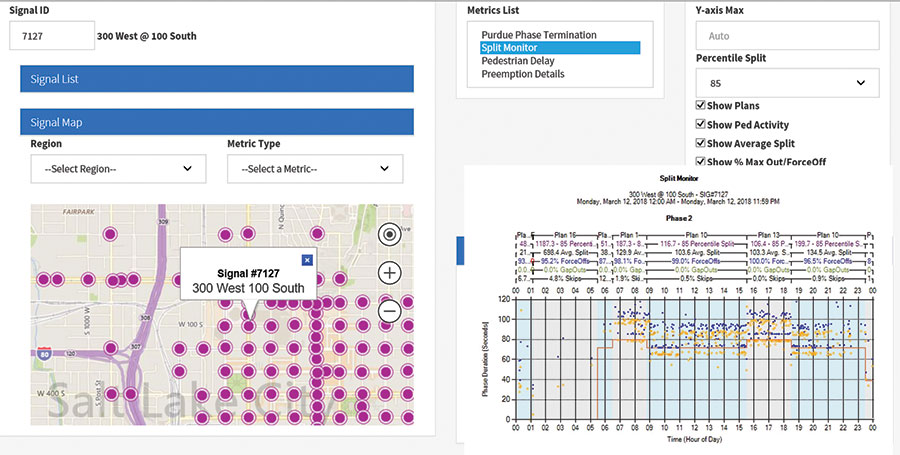Automated Traffic Signal Performance Measures Case Studies:
Utah Department of Transportation
Printable Version [PDF, 1.9MB]
You may need the Adobe® Reader® to view the PDFs on this page.
Contact Information: Operations Feedback at OperationsFeedback@dot.gov

U.S. Department of Transportation
Federal Highway Administration
Office of Operations
1200 New Jersey Avenue, SE
Washington, DC 20590
FHWA-HOP-18-048
September 2018
UDOT TRAFFIC SIGNAL PROGRAM OVERVIEW

TRAFFIC SIGNAL SYSTEMS CAPABILITY MATURITY SELF ASSESSMENT

Traffic Signal Systems Capability Maturity Self-Evaluation Tool: https://ops.fhwa.dot.gov/tsmoframeworktool/tool/tssc/
ATSPM CAPABILITY

Photo Credit: UDOT
"Signal performance measures have enabled the State of Utah to do more with less, focus our resources on the areas of most need, and to more effectively prioritize resources and workload."
Mark Taylor
Traffic Signal Operations Engineer, UDOT
Automated Traffic Signal Performance Measures (ATSPM) are a cost-effective way for agencies to measure and display signalized intersection performance. ATSPM enables UDOT to proactively manage traffic signal timing and quickly identify maintenance issues that affect traffic flow. UDOT's ATSPM program benefited from its partnership with Purdue University, FHWA, and the Transportation Pooled Fund Program. Today, UDOT's ATSPM contains a suite of data visualization reports that can be used to evaluate the quality of traffic progression along corridors and identify unused green time for allocation to other intersection movements. System reports of vehicle delay, volumes, and speeds can be used to evaluate the effectiveness of signal timing adjustments. ATSPM visualizations can also be used to inform UDOT staff of vehicle and pedestrian detector malfunctions, saving staff time during maintenance operations. ATSPM tools speed up decision making and help UDOT staff prioritize operation and maintenance efforts. UDOT's ATSPM also features a public-facing website http://udottraffic.utah.gov/atspm/ that allows users to generate charts for the following performance metrics:
- Approach delay
- Approach volume
- Arrivals on red
- Coordination diagram
- Purdue split failure
- Pedestrian delay
- Phase termination
- Preemption details
- Split failure
- Split monitor
- Turning movement counts
Since implementing its ATSPM program, UDOT has noted a significant drop in public complaints and requests for traffic signal retiming. The ATSPM system quickly identifies problems such as failed detectors and sends a simple email notification. These alerts allow UDOT to respond to issues before they become public nuisances and prolonged threats to mobility.
ATSPM SYSTEM MATURITY
UDOT is collecting ATSPM at 96 percent of its 1,223 traffic signals. Partner agencies have connected 79 percent of their 852 signals and report data through the same centralized operation. Utah's end goal is to have all signals statewide connected and contributing data to their existing ATSPM system.
BUDGET
From November 2012 to February 2018, UDOT has invested approximately 8,000 hours to the implementation and improvement of ATSPM. UDOT's 2017 annual maintenance budget was approximately $3,500 per signal. The agency's Traffic and Safety Division commits approximately $7 million annually for new traffic signals. UDOT estimates implementation costs for small ATSPM systems (about 50 signals) would be approximately $20,000. Large systems (on the order of 1,000 signals) would be approximately $230,000.
"It's not launching a space shuttle. The information technology and software have been worked out and installation is easy using in-house IT or consultants." - Mark Taylor
RETURN ON INVESTMENT
The ATSPM program was developed with high return on investment in mind. Resources invested in the program provide high-value benefits including the ability to assess and improve traffic flow, detect system malfunctions, and quantify multiple measures of performance. This reduces congestion and emissions, and improves safety and operation and maintenance efficiency. UDOT's ATSPM implementation is designed to be cost-effective and not reliant on costly proprietary applications or a centralized traffic management system. Nevertheless, resource investments are needed to connect new signals and repair existing signal ATSPM hardware, as well as monitor and manage the system.

Graphic Credit:UDOT
UDOT's ATSPM public-facing website and toolkitATSPM IMPLEMENTATION
The UDOT ATSPM system operates independently of their central traffic signal system and is based around the following architecture. High-resolution traffic signal controllers are used to store detailed signal phase and timing information as well as detector data associated with each equipped intersection. An Ethernet network and file transfer protocol connections are used to transfer high-resolution controller data from each intersection to the ATSPM central server every 15 minutes. ATSPM central servers provide data warehouse and web server functions. UDOT's ATSPM software was developed in-house by UDOT's Department of Technology Services. Data loggers are equipped with nonproprietary firmware to collect high-resolution data. UDOT's ATSPM allows for the interoperable use of controllers from different manufacturers, and is publicly available under an open source license at
https://www.itsforge.net and https://github.com/udotdevelopment/atspm.
ADDITIONAL RESOURCES
For additional information please contact:
Eddie Curtis, FHWA Resource Center, 404-562-3920, Eddie.Curtis@dot.gov

Every Day Counts (EDC), a State-based initiative of FHWA's Center for Accelerating Innovation, works with State, local, and private sector partners to encourage the adoption of proven technologies and innovations aimed at shortening and enhancing project delivery.
www.fhwa.dot.gov/innovation/everydaycounts/